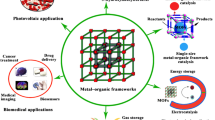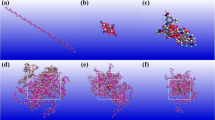Abstract
In this work, the thermally stable magnetic poly(urethane-imide) nanocomposite (β-CDPUIm-MNPs (9)) was prepared by reaction of β-cyclohexatriene with diisocyante (5) as a new synthetic cross linker agent and its adsorption behavior for removal of heavy metal ions from water was examined and compared with bare poly(urethane-imide). This poly(urethane-imide) based nanocomposite was employed for the removal of Pb(II) and Cd(II) metals from the waste water for the first time and it has proved to have an excellent efficiency probably due to the presence of nitrogen and oxygen atoms in the imide ring. β-CDPUIm-MNPs (9) displayed highly effective adsorption performance to lead and cadmium and showed maximum adsorptions during 20 min. For optimization of lead and cadmium ions adsorption, the effects of different factors like pH, contact time, and initial amounts of Pb(II) and Cd(II) ions were studied. Results showed that pH has a great influence on the adsorption behavior and also maximum adsorption capacity was obtained at pH 7. Examination of the isotherm and adsorption kinetics showed that equilibrium adsorptions and kinetic are well-modeled by applying Langmuir isotherm model and pseudo-second-order kinetics, respectively. The maximum adsorption capacities of β-CDPUIm-MNPs (9) for Pb(II) and Cd(II) ions based on Langmuir isotherm calculation were 344.830 and 303.030 mg/g, respectively. Regenerated β-CDPUIm-MNPs (9) were used as adsorbent and show high adsorption capacity without any reductions of magnetic intensity and aggregation of adsorbents under five repeating cycles.

















Similar content being viewed by others
References
Bora T, Dutta J (2014) Applications of nanotechnology in wastewater treatment—a review. J Nanosci Nanotechnol 14(1):613–626
Badruddoza AZM, Shawon ZBZ, Tay WJD, Hidajat K, Uddin MS (2013) Fe3O4/cyclodextrin polymer nanocomposites for selective heavy metals removal from industrial wastewater. Carbohydr Polym 91(1):322–332
Li T, Liu X, Li L, Wang Y, Ma P, Chen M, Dong W (2019) Polydopamine-functionalized graphene oxide compounded with polyvinyl alcohol/chitosan hydrogels on the recyclable adsorption of cu (II), Pb (II) and cd (II) from aqueous solution. J Polym Res 26(12):281
Abdolmaleki A, Mallakpour S, Mahmoudian M, Sabzalian MR (2017) A new polyamide adjusted triazinyl-β-cyclodextrin side group embedded magnetic nanoparticles for bacterial capture. Chem Eng J 309:321–329. https://doi.org/10.1016/j.cej.2016.10.063
Ozay O, Ekici S, Baran Y, Aktas N, Sahiner N (2009) Removal of toxic metal ions with magnetic hydrogels. Water Res 43(17):4403–4411
Imiete IE, Viacheslovovna Alekseeva N (2018) Reverse osmosis purification: a case study of the Niger Delta region. Water Sci 32(1):129–137
Hunsom M, Pruksathorn K, Damronglerd S, Vergnes H, Duverneuil P (2005) Electrochemical treatment of heavy metals (Cu2+, Cr6+, Ni2+) from industrial effluent and modeling of copper reduction. Water Res 39(4):610–616
Ansari A, Vahedi S, Tavakoli O, Khoobi M, Faramarzi MA (2019) Novel Fe3O4/hydroxyapatite/β-cyclodextrin nanocomposite adsorbent: synthesis and application in heavy metal removal from aqueous solution. Appl Organomet Chem 33(1):e4634
Seo S, Sung B, Kim G, Chu K, Um C, Yun S, Ra Y, Ko K (2010) Removal of heavy metals in an abandoned mine drainage via ozone oxidation: a pilot-scale operation. Water Sci Technol 62(9):2115–2120
Walker DJ, Hurl S (2002) The reduction of heavy metals in a stormwater wetland. Ecol Eng 18(4):407–414
Dąbrowski A, Hubicki Z, Podkościelny P, Robens E (2004) Selective removal of the heavy metal ions from waters and industrial wastewaters by ion-exchange method. Chemosphere 56(2):91–106
Rima J, Assaker K (2013) B-Cyclodextrin polyurethanes copolymerised with beetroot fibers (bio-polymer), for the removal of organic and inorganic contaminants from water. J Food Res 2(1):150
Taka AL, Pillay K, Mbianda XY (2017) Nanosponge cyclodextrin polyurethanes and their modification with nanomaterials for the removal of pollutants from waste water: a review. Carbohydr Polym 159:94–107
Gupta VK, Ali I, Saini VK (2007) Defluoridation of wastewaters using waste carbon slurry. Water Res 41(15):3307–3316
Crini G (2005) Recent developments in polysaccharide-based materials used as adsorbents in wastewater treatment. Prog Polym Sci 30(1):38–70
Shayegan H, Ali GAM, Safarifard V (2020) Recent Progress in the removal of heavy metal ions from water using metal-organic frameworks. ChemistrySelect 5(1):124–146. https://doi.org/10.1002/slct.201904107
Zhuang S, Yin Y, Wang J (2018) Simultaneous detection and removal of cobalt ions from aqueous solution by modified chitosan beads. Int J Environ Sci Technol 15(2):385–394
Wang J, Zhuang S (2017) Removal of various pollutants from water and wastewater by modified chitosan adsorbents. Crit Rev Environ Sci Technol 47(23):2331–2386
Wang J, Chen C (2009) Biosorbents for heavy metals removal and their future. Biotechnol Adv 27(2):195–226
Cathum SJ, Boudreau A, Obenauf A, Dumouchel A, Brown CE, Punt M (2006) Treatment of mixed contamination in water using cyclodextrin-based materials. Remediat J 16(4):43–56
Mirzajani R, Pourreza N, Najjar SSA (2014) β-Cyclodextrin-based polyurethane (β-CDPU) polymers as solid media for adsorption and determination of Pb (II) ions in dust and water samples. Res Chem Intermed 40(8):2667–2679
Tudisco C, Oliveri V, Cantarella M, Vecchio G, Condorelli GG (2012) Cyclodextrin anchoring on magnetic Fe3O4 nanoparticles modified with phosphonic linkers. Eur J Inorg Chem 2012(32):5323–5331
Xie A, Zhang M, S-i I (2016) Influence of β-cyclodextrin on morphologies and chemical, thermal, and mechanical properties of non-chain extended polyurethane elastomers. J Polym Res 23:1–9
Ogoshi T, Harada A (2008) Chemical sensors based on cyclodextrin derivatives. Sensors 8(8):4961–4982
Dardeer HM (2014) Importance of cyclodextrins into inclusion complexes. Int J Adv Res 2(4):414–428
Morin-Crini N, Crini G (2013) Environmental applications of water-insoluble β-cyclodextrin–epichlorohydrin polymers. Prog Polym Sci 38(2):344–368
Mhlanga SD, Mamba BB, Krause RW, Malefetse TJ (2007) Removal of organic contaminants from water using nanosponge cyclodextrin polyurethanes. J Chem Technol Biotechnol 82(4):382–388
Kumar A, Kumari A, Asu S, Laha D, Kumar Sahu S (2019) Synthesis of CDs from β-Cyclodextrin for smart utilization in visual detection of cholesterol and cellular imaging. ChemistrySelect 4(48):14222–14227. https://doi.org/10.1002/slct.201903680
Zhu X, Wu M, Gu Y (2009) β-Cyclodextrin-cross-linked polymer as solid phase extraction material coupled with inductively coupled plasma mass spectrometry for the analysis of trace co (II). Talanta 78(2):565–569
Gnanarajan TP, Nasar AS, Iyer NP, Radhakrishnan G (2000) Synthesis of poly(urethane-imide) using aromatic secondary amine-blocked polyurethane prepolymer. J Polym Sci A Polym Chem 38(22):4032–4037. https://doi.org/10.1002/1099-0518(20001115)38:22<4032::Aid-pola30>3.0.Co;2-r
Chattopadhyay D, Mishra AK, Sreedhar B, Raju K (2006) Thermal and viscoelastic properties of polyurethane-imide/clay hybrid coatings. Polym Degrad Stab 91(8):1837–1849
Qu X, Alvarez PJ, Li Q (2013) Applications of nanotechnology in water and wastewater treatment. Water Res 47(12):3931–3946
Saberi A, Alipour E, Sadeghi M (2019) Superabsorbent magnetic Fe 3 O 4-based starch-poly (acrylic acid) nanocomposite hydrogel for efficient removal of dyes and heavy metal ions from water. J Polym Res 26(12):271
Yu L, Xue W, Cui L, Xing W, Cao X, Li H (2014) Use of hydroxypropyl-β-cyclodextrin/polyethylene glycol 400, modified Fe3O4 nanoparticles for Congo red removal. Int J Biol Macromol 64:233–239
Zhu Y, Hu J, Wang J (2012) Competitive adsorption of Pb (II), cu (II) and Zn (II) onto xanthate-modified magnetic chitosan. J Hazard Mater 221:155–161
Yuwei C, Jianlong W (2011) Preparation and characterization of magnetic chitosan nanoparticles and its application for cu (II) removal. Chem Eng J 168(1):286–292
Kiasat AR, Nazari S (2012) Magnetic nanoparticles grafted with β-cyclodextrin–polyurethane polymer as a novel nanomagnetic polymer brush catalyst for nucleophilic substitution reactions of benzyl halides in water. J Mol Catal A Chem 365:80–86
Fathi M, Entezami AA (2014) Stable aqueous dispersion of magnetic iron oxide core–shell nanoparticles prepared by biocompatible maleate polymers. Surf Interface Anal 46(3):145–151
Ranganath KV, Glorius F (2011) Superparamagnetic nanoparticles for asymmetric catalysis—a perfect match. Catal Sci Technol 1(1):13–22
Eibagi H, Faghihi K, Komijani M (2020) Synthesis of new environmentally friendly poly (urethane-imide) s as an adsorbent including β-cyclodextrin cavities and attached to iron nanoparticles for removal of gram-positive and gram-negative bacteria from water samples. Polym Test 90:106734
Faghihi K, Jalalian M (2008) Synthesis and characterization of new heat-resistance polymers based on N-(4-carboxy phenyl) trimellitimide and aromatic diamines. J Iran Chem Res 1(2):95–102
Can K, Ozmen M, Ersoz M (2009) Immobilization of albumin on aminosilane modified superparamagnetic magnetite nanoparticles and its characterization. Colloids Surf B: Biointerfaces 71(1):154–159
Ozaki S (1972) Recent advances in isocyanate chemistry. Chem Rev 72(5):457–496
Le HV, Ganem B (2011) Trifluoroacetic anhydride-catalyzed oxidation of isonitriles by DMSO: a rapid, convenient synthesis of isocyanates. Org Lett 13(10):2584–2585
Yoganathan S, Miller SJ (2013) N-Methylimidazole-catalyzed synthesis of carbamates from hydroxamic acids via the Lossen rearrangement. Org Lett 15(3):602–605
Solanki A, Sanghvi S, Devkar R, Thakore S (2016) β-Cyclodextrin based magnetic nanoconjugates for targeted drug delivery in cancer therapy. RSC Adv 6(101):98693–98707
Kiasat AR, Nazari S (2013) β-Cyclodextrin conjugated magnetic nanoparticles as a novel magnetic microvessel and phase transfer catalyst: synthesis and applications in nucleophilic substitution reaction of benzyl halides. J Incl Phenom Macrocycl Chem 76(3–4):363–368
Guo X, Wang J (2019) Comparison of linearization methods for modeling the Langmuir adsorption isotherm. J Mol Liq 296:111850
Deng J-H, Zhang X-R, Zeng G-M, Gong J-L, Niu Q-Y, Liang J (2013) Simultaneous removal of cd (II) and ionic dyes from aqueous solution using magnetic graphene oxide nanocomposite as an adsorbent. Chem Eng J 226:189–200
Li X, Wang S, Liu Y, Jiang L, Song B, Li M, Zeng G, Tan X, Cai X, Ding Y (2017) Adsorption of cu (II), Pb (II), and cd (II) ions from acidic aqueous solutions by diethylenetriaminepentaacetic acid-modified magnetic graphene oxide. J Chem Eng Data 62(1):407–416
Duan C, Zhao N, Yu X, Zhang X, Xu J (2013) Chemically modified kapok fiber for fast adsorption of Pb 2+, cd 2+, cu 2+ from aqueous solution. Cellulose 20(2):849–860
He J, Li Y, Wang C, Zhang K, Lin D, Kong L, Liu J (2017) Rapid adsorption of Pb, cu and cd from aqueous solutions by β-cyclodextrin polymers. Appl Surf Sci 426:29–39
Zhang Q, He M, Chen B, Hu B (2018) Magnetic mesoporous carbons derived from in situ MgO template formation for fast removal of heavy metal ions. ACS Omega 3(4):3752–3759
Kalaivani S, Muthukrishnaraj A, Sivanesan S, Ravikumar L (2016) Novel hyperbranched polyurethane resins for the removal of heavy metal ions from aqueous solution. Process Saf Environ Prot 104:11–23
Fan L, Luo C, Sun M, Li X, Qiu H (2013) Highly selective adsorption of lead ions by water-dispersible magnetic chitosan/graphene oxide composites. Colloids Surf B: Biointerfaces 103:523–529
Zou Y, Wang X, Ai Y, Liu Y, Ji Y, Wang H, Hayat T, Alsaedi A, Hu W, Wang X (2016) β-Cyclodextrin modified graphitic carbon nitride for the removal of pollutants from aqueous solution: experimental and theoretical calculation study. J Mater Chem A 4(37):14170–14179
Wang J, Guo X (2020) Adsorption kinetic models: physical meanings, applications, and solving methods. J Hazard Mater 390:122156
Guo X, Wang J (2019) A general kinetic model for adsorption: theoretical analysis and modeling. J Mol Liq 288:111100
Acknowledgments
We appreciate financial support of Research Concil of Arak University.
Author information
Authors and Affiliations
Corresponding author
Additional information
Publisher’s note
Springer Nature remains neutral with regard to jurisdictional claims in published maps and institutional affiliations.
Rights and permissions
About this article
Cite this article
Eibagi, H., Faghihi, K. Preparation of thermally stable magnetic poly(urethane-imide)/nanocomposite containing β-cyclodextrin cavities as new adsorbent for lead and cadmium. J Polym Res 27, 301 (2020). https://doi.org/10.1007/s10965-020-02255-6
Received:
Accepted:
Published:
DOI: https://doi.org/10.1007/s10965-020-02255-6




